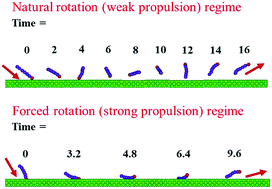Mechanical pressure, surface excess, and polar order of a dilute rod-like nanoswimmer suspension: role of swimmer–wall interactions
Abstract
The mechanical pressure, surface excess, and polar order of a dilute rod-like nanoswimmer suspension confined by two parallel plates are explored by dissipative particle dynamics. The accumulation and preferred orientation of swimmers near the walls are distinctly shown through the density and polar order distributions for various active force, Fa, values and rod lengths. As Fa is increased, it is interesting to observe that there exists a maximum of the polar order, revealing that the dominant mechanism of the swimmer behavior can be altered by the coupling between the active force and the rod–wall interaction. As a result, the influences of the active force on the swim pressure Π(w)a contributed by the swimmers directly and the surface excess Γ* can be classified into two scaling regimes, natural rotation (weak propulsion) and forced rotation (strong propulsion). Π(w)a and Γ* are proportional to Fa2 in the former regime but become proportional to Fa in the latter regime. For all rod–wall repulsions, the swim pressure of active rods in confined systems Π(w)a always differs from that in unbounded systems Π(b)a which is simply proportional to Fa2 associated with the active diffusivity. That is, unlike thermal equilibrium systems, Π(w)a is not a state function because of the presence of the wall-torque.



 Please wait while we load your content...
Please wait while we load your content...